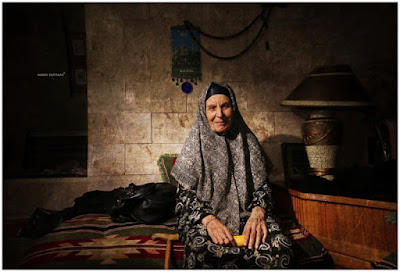Twitter QA: The Magic Lamp

I get Twitter upstreams pretty often, and enjoy seeing photos from Strobist readers and answering questions when possible. I don't do full-blown critiques or portfolio reviews because of time restraints and an utter lack of any qualification to judge other photographers on my part. But a pic and a Q? Sure, I'm down for that.
Reader Mans Duffani, from Benghazi, Libya tweeted the above photo—a beautiful portrait—to me. It's a great example of a strong photo that could have been made even better if Mans had taken a moment while shooting to consider the image from front to back.
Think Inside the Box
Long-time Washington Post staff photographer Michael Williamson put a bug in the back of my brain about 20 years ago that has stuck with me ever since: when shooting with a wideangle lens, consider the frame to be three-dimensional rather than two-dimensional.
Think box, as opposed to a rectangle: top to bottom, left to right, front to back.
That's a whole Zen wideangle philosophy in itself. And it is something that the "natural" wideangle shooters I have known (looking at you, Stephanie Boyar) seem to get intuitively.
As for me, it's something that I always try to work on. Especially with regard to lighting, as lighting gives us the ability to exploit the three-dimensionality of the frame with a lot of control.
__________
So let's look at what Mans did, and then stretch the thinking just a little more.
He's at a family event, celebrating a graduation. He sees a relative sitting in a great environment. Ridiculously great, I think we can all agree. Seriously, could you prop a scene better than that in a studio? I think not.
So he runs out to grab his camera, a Canon 70D and a kit zoom. For light, a single, bare speedlight. Didn't even have a light stand, so he had his aunt hold the flash for him. VAL for the win.
And yeah, there's no soft box on hand, so the light's pretty hard. But that is doing two things for him. One, it is showing off the character in his subject's face. And two, the light has an edge to it because of the speedlight's built-in reflector. And Mans is using the beam to feather the background into darkness.
Sure, some of that might have been in post. But the fact that the flash is bare (no soft mod) gave him the ability to control the spill in a number of ways. And that darkness gives a lot of character to the photo. And it also gives an opportunity.
Remember to Use All of Your Lights
Here's Mans' EXIF info:
Shutter: 1/200 (nice, high sync speed: kill the ambient, let the flash define the room.)
Aperture: f/16 (again, killing even more ambient here. Going for drama.)
In other words, before he exposes with the flash, he has set his camera to render the available light in the frame to pure black. That's all flash in the final image. And it works great. But it could work just a little better.
The dark background at camera right, with that beautiful lamp. With an opaque shade. That lamp is just begging to be turned on.
Think of it: it's not even gonna push straight into the camera (opaque shade!) It's just going to caress that background with some sculpting light. And since the light is in the frame, it will illuminate that area beautifully and three-dimensionally.
How bright? That's the best part: that call is totally up to you. In fact, that's what you're going to do first. Before you ever setup/adjust your flash, you'd want to turn that lamp on and walk that shutter speed down from 1/200s until the glow of the lamp in that black background looked just gorgeous.
How much ambient exposure? Again, it's up to you. No wrong answers here. But for me, I am thinking less is more. Just some rich color from inside the frame. Rub that lamp just a tad with some extra shutter speed until the genie comes out. Might be 1/60th. Might be 1/15th. You won't know until you look.
No worries if you have some minor shakes—the flash will freeze your subject. The lamp might even splash just a tiny rim light on her, too.
And once you get the lamp dialed in, then you build your flash exposure. So now, the areas of darness left by your flash are being pushed into by the controlled, subtle glow of a lamp in the scene.
When I look at that photo, the lamp is turned on in my mind. Believe me, it looks great.
__________
No fault to Mans. When we light photos, it is all too easy to concentrate in what we are bringing to the scene (after all, we're lighting photographers!) and to miss what the scene is offering us. That's one reason I always assess the ambient quality of a scene over a range of different exposures before I even think about adding light.
Maybe I'll end up going with black-ambient, like Mans did. Or maybe a mostly black ambient will work better. Or maybe I'll turn on that lamp and walk the ambient exposure around until that back-camera-right area looks uh-mazing.
Then I'll light the subject. But just like Mans did, I'll probably zoom the flash to 105mm and feather it down a bit to make sure and preserve the "flash" darkness around the lamp.
__________
New to Strobist? Start here | Or jump right to Lighting 101
My new book: The Traveling Photograher's Manifesto
Permalink
<< Home